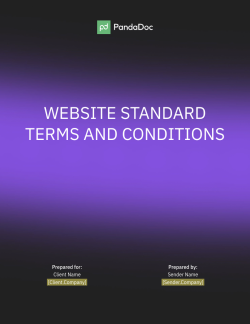If your proposal is the car, the terms and conditions (T&Cs) are its seatbelts. Even if you win the deal, without appropriate T&Cs you’re taking a considerable risk if something goes wrong.
So, it’s vital that you know how to write terms and conditions that are appropriate for your particular business needs.
Luckily, writing terms and conditions isn’t that difficult. In fact, you’re merely outlining the details concerning:
- Who is and isn’t responsible for what (your website terms and conditions should have a disclaimer clearly stating this)
- How long it will take
- What happens when some changes are made
- How much it will cost
Terms and conditions can help you avoid any uncertainty regarding the execution of the project or deal.
Moreover, they ensure that you and your client are on the same page while also reducing the risk of conflicts and differing expectations.
You need to make sure that the terms are clear with little room for contradictory interpretations, but always include a section regarding dispute resolution just in case.
For example: Does your client understand that you’re only providing two designs as those are the ones included in the budget? Do you both agree on the terms as to when the project will be officially completed?
While the proposal can cover various vital concerns, there are also fundamental issues that you need to deal with:
- Who’s hiring whom, the purpose of the hiring, the project duration, and the cost
- What the two parties have agreed to, with a clear statement as to their respective responsibilities
- The specific details of the project and what isn’t included
- What to do if someone changes their mind or wants to cancel—include a termination clause that clearly states what happens in the event of someone canceling
- A clear understanding of the liabilities and other legal matters, as they relate to the applicable law in your jurisdiction
Some business owners (especially owners of SaaS companies, software developers who provide mobile apps, and other digital product providers) are hesitant to include T&Cs up front if the clients haven’t signed up yet.
Instead, they include them in a separate document, such as the confirmation of works.
This isn’t a viable way to form a contract as the client must be aware of all the conditions relating to the works before they sign up.
Otherwise, it’s not legally enforceable.
If terms and conditions are well written and fair, your clients will not be put off by them.
Instead, they’ll be reassured that they’re dealing with a professional company and both parties’ interests are protected.
How to write a terms and conditions document
1. Compose the introduction
To begin your terms and conditions document, highlight the name of your service or product.
This is similar to the first step when you learn how to write a business contract.
Include all affiliates, trade names, subsidiaries, and parent companies at the top of your terms and conditions and above the contract’s details.
2. Outline the terms and conditions
When you’re writing terms and conditions, ensure you do so clearly using simple language.
Your proposals’ and website’s simple terms and conditions must be thorough and address all legal issues, meaning you won’t be at risk of liabilities.
3. Write a customer service acknowledgment statement
For your T&Cs to be valid, include a customer service acknowledgement statement.
This typically follows wording such as:
“The undersigned agrees to the terms and conditions included herein.”
4. List the rightful owner
To ensure that you limit your liability, include information about the tasks and actions you’re not responsible for.
Create a list of prohibited actions so they’re clear to the end-user.
5. Create private policy
Your privacy policy is another element of your simple terms and conditions.
This section dictates how you plan to handle sensitive customer data.
Add information about opting out from selling or sharing information.
6. Add both parties’ signatures and the dateline
At the end of the terms and conditions, it’s vital to add a dateline and space for both parties’ signatures.
What is included in terms and conditions?
Everyone involved in the contract must understand the terms and conditions.
This may not be a straightforward concept as, inevitably, some legal and business terminology will be included in the document.
So, in order to avoid any misunderstandings or confusion, ensure you define any “difficult” words or phrases.
You should also keep the language simple and easily accessible.
Include the following, under clear and easy to understand headings:
1. The price and payment method
Your proposal must include the final price.
You should also include a payment schedule that your client can follow. Besides the price, consider adding other critical items, such as the taxes payable.
Furthermore, you should also incorporate a provision regarding non-payment.
2. Privacy issues
You can bolster your client’s confidence by including a privacy statement in your terms and conditions agreement.
Data protection is vital, and depending on the governing law of your state or country, there may be specific data protection laws, such as GDPR, that you must follow.
You need to assure clients that you won’t sell, share, or rent their personal data to any other entities, including third-party websites.
Provide clients with details about how you’ll protect their sensitive information, such as credit card details and contact information.
3. Intellectual property rights
Once you have provided your clients with something valuable, they’ll want to claim ownership over that property.
Therefore, you need to make sure that you mention that you’re assigning all the rights, interests, or intellectual properties developed in the project.
However, make it clear to the client that they won’t have ownership over the IP unless the invoice is fully paid.
Some companies prefer to keep the IP in their work and instead give their clients a license to use the work for their own purposes.
If this is the case, you need to be clear on any restrictions on that license and what it can be used for.
4. Sharing of work
To increase your business, you’ll often provide prospective clients with examples of your work, such as case studies or portfolios.
While many of your clients will be okay with this type of promotion, others may have reservations due to security and competition concerns.
To avoid any misunderstanding, consider adding a clause that specifies whether the work will be included in such promotions.
5. Provisions for any changes
There’s always the possibility that clients may change their mind with regard to the project.
So it’s crucial that you include details about what will happen if the project is changed partway through.
You need to include:
- How requests for changes will be agreed
- Who’s responsible for any changes
- How it can be handled within the budget or what charges shall be imposed as additional
- Allowable adjustments to the timeframes
- Implications for the project if the changes are agreed
It’s essential that your T&Cs cover these details from the outset as they’ll manage the expectations of both parties and keep everyone focused on the goals.
6. Cancellation clauses
A client may decide to cancel the project even if the contract has been signed and approved.
Naturally, such a negative outcome could cost you money, especially if you’ve started the work. As a result, it’s vital that you protect yourself.
Your T&Cs can specify:
- How much notice is required to cancel the contract
- The implications of stopping the project
- What happens to the deposit and if there are other fees involved in cancellation
7. Fees for delay or termination
Other problems can arise even if the contract has been agreed.
As an example, perhaps in the middle or toward the end of a project, the client stops communicating or just disappears.
Despite your repeated emails and calls, you receive no response from them.
So, you shelve the project as it cannot go forward without confirmation from the client.
However, after some time, the client suddenly sends an email asking when you can launch the project.
To prevent such a scenario from occurring, your contract should state what will happen if the client delays the project.
You may require full payment for the works despite their incompletion.
They may need to pay a certain sum or undergo a specified waiting period before you resurrect a dormant project.
You may not be able to continue where you left off, and they may have to pay to start the project again.
Regardless of your scenario, the fees for delay or termination need to be clear from the outset.
8. How to address errors or omissions
Mistakes occur in all sorts of situations, so you must ensure that your proposal covers you legally so that you cannot be sued for:
- Making errors
- Failing to take actions
- Project delays that can cause lost profits or damages
- Failure by the client to proofread or check the works
- Underlying issues with the site or materials provided by the client
Some clients may not like adding these clauses. However, it’s essential that you at least have some protection in case of any oversights.
9. Hiring a legal expert or lawyer
As you’ll be dealing with legal documents to cover the project, you should consider hiring a lawyer or legal expert for your contracts and T&Cs.
Or, if you already have one, they could perhaps take a look and provide you with relevant legal advice and ensure that all your documents are legally compliant.

Website Standard Terms and Conditions Template
Used 6829 times
Use this free Website Standard Terms and Conditions Template to disclose legal obligations and protect your copyright, along with other overriding jurisdiction.
Use this templateProtect your business by writing terms and conditions
Before asking a client to sign the terms and conditions, you should make sure that you explain the details to them.
Sometimes, people sign legal documents without thoroughly reading or understanding their content.
Furthermore, don’t begin work on the project until the contract has been agreed.
If the client agrees to your proposal, they should agree to your own terms and conditions as well.
Some clients may insist on commencing the project without having a signed contract.
However, that’s a path that you should never take. Instead, why not trust PandaDoc to help you with your contract creation and management?
PandaDoc makes it simple to draw up, customize, and sign contracts.
What’s more, you can easily collaborate on them, too, both with your colleagues and with other interested parties.
So, you and your prospective client could, for example, thrash out a contract’s terms and conditions in minutes—all within the document itself. How easy does that sound?!
Frequently asked questions about terms and conditions
-
Writing terms and conditions for a contract should include the subject matter, the price of the service, payment terms, definition of services and functionality, and any provisions relating to delivery, carriage, risk, and insurance.
In addition, you’ll need to include termination of contract provisions, intellectual property rights protection, client indemnity processes, and limitation of liability.
PandaDoc’s website standard terms and conditions template can help ensure you don’t miss anything.
-
Terms and conditions for your invoices must have key elements to make invoices as clear as possible. These elements include terms of sale (cost, amount, delivery, payment method, due date).
If you accept payment in advance or require immediate payment, be sure to include information on this, too. You’ll need to add steps on warranty terms and any late payment penalties and cancelation fees.
-
In a quotation document, it’s important to create payment terms and conditions that your clients must adhere to and agree upon in advance.
To make it simple to read, include the total of the services, together with a full breakdown of costs, including any potential revisions or variations.
Add your payment terms and conditions, preferred payment methods, and space for a customer acceptance signature.
-
Terms and conditions don’t need to be signed to be legally-binding and enforceable. You must have some evidence, however, that your client has accepted the terms and conditions.
For example, if you display your terms and conditions online, you can obtain acceptance of your terms and conditions with a “clickwrap” prompt. This is common on websites and when people sign up to user accounts online.
Originally published February 10, 2020, updated February 13, 2023
Disclaimer
PandaDoc is not a law firm, or a substitute for an attorney or law firm. This page is not intended to and does not provide legal advice. Should you have legal questions on the validity of e-signatures or digital signatures and the enforceability thereof, please consult with an attorney or law firm. Use of PandaDocs services are governed by our Terms of Use and Privacy Policy.


